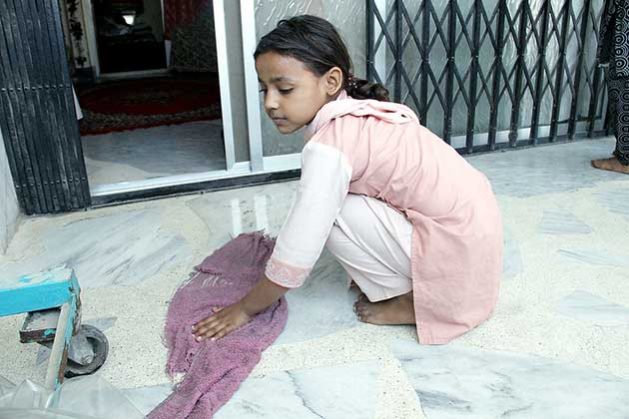
A Pakistani child domestic worker. Credit: Fahim Siddiqi /IPS
KUALA LUMPUR, Malaysia, Jun 11 2020 (IPS) – Even before Covid-19, the world was facing a care crisis. The plight of often neglected, under-appreciated, under-protected and poorly equipped ‘frontline’ health personnel working to contain the pandemic has drawn attention to the tip of the care crisis iceberg.
Rising care work burden
Ageing populations as well as cuts to public services and social protection were making matters worse, increasing the burden on carers, or care givers/providers, regardless of their employment status.
Elderly people need long-term care as they age, while existing social arrangements, including government services, remain inadequate and ill prepared. Such demands on caregivers will continue to increase as populations grow and people live longer.
’s annual early 2020 Davos report, Time to Care, estimates that 2.3 billion people will need care by 2030, 200 million more than in 2015, including 100 million more older people and an additional 100 million children aged 6 to 14 years.
Care work, unpaid or underpaid, is generally not visible, greatly undervalued and typically taken for granted. It is often not considered real or proper ‘work’, with spending for care work considered a cost, not an investment.
The nature of care work and gender discrimination undermines the health and well-being of its mainly female workers. Women and girls, especially the poor and marginalized, do , and much more for poor wages.
The women and girls are left ‘time-poor’, often unable to meet their own needs. Consequently, they have less time for education and paid work, let alone fully participate socially and politically.
Unpaid care work
The study argued that unpaid care work is essential for our economies, businesses and societies. However, unpaid care work is often underappreciated when measuring economic progress and social wellbeing, not least because this burden is mainly borne by women and girls, who do more than three-quarters of all unpaid care work.

Jomo Kwame Sundaram
Oxfam estimates that the globally, for women aged 15 and over, is at least US$10.8 trillion annually. Although high, this figure is still believed to be an underestimate, with the true figure far higher.
Women thus often earn less because their unpaid care work limits their time for paid work; in fact, 42 per cent of working age women, compared to six per cent of males, cannot get paid work due to their caregiving responsibilities.
Climate change is also increasing the need for unpaid care. will be living in areas without enough water, forcing women and girls to carry more water even further. Also, as global warming and other developments adversely affect health and food production, many women and girls will have to work more to cope.
Domestic workers
, especially as , among the most poorly treated employees in the world. Hence, they are also more likely to be in undesirable, poorly paid, dirty and precarious jobs.
Only about by labour laws as much as other workers, while only around half have minimum wage protection. For , national laws do not limit working hours.
Meanwhile, , or about three-fifths of the wages due to them. Forced labour and trafficking cause in other people’s homes”, with “their lives controlled”, but also “rendered invisible and unprotected”.
Two-thirds of the paid ‘care workforce’ are women. Jobs such as nursery workers, domestic workers, and ‘care assistants’ are often physically and emotionally draining, besides being poorly paid, with few benefits, despite having to work irregular hours.
Redistributing care burden
The Oxfam report notes that governments greatly under-tax the wealthy, and hence do not collect enough revenue to better fund vital public services, including social services and infrastructure.
Progressive taxation and spending, including subsidized social services and social protection, would reduce the burden of care work and social inequality. Better investments in electricity, water, sanitation, childcare and healthcare would improve the quality of care workers’ lives by easing their care work responsibilities.
Such efforts should recognize unpaid and poorly paid care work as providing real value. Better, affordable and equitable access to time-saving care-supporting infrastructure and devices would also reduce the burden of unpaid care tasks.
With government and employers reducing the burden of care work, redistributing unpaid care work more fairly within households would become more feasible. Enabling meaningful participation by care givers, paid and unpaid, in policy-making would also help.
Oxfam proposals
various actions, including national care systems, to help care givers including: improving the lot of both the unpaid and the underpaid; addressing the greater burden on women and girls; improving and protecting care workers’ rights, with paid employees entitled to living wages and decent working conditions.
Governments were urged to ratify ILO Convention 189, protecting domestic workers and eliminating gender wage gaps. Societies should also challenge the harmful and discriminatory social and cultural norms that care work is the responsibility of women and girls, including by encouraging men and boys to share care work responsibilities.
must also recognize the value of care work for employees’ wellbeing and productivity. Employers should provide benefits and services, such as crèches and other childcare entitlements, while ensuring decent working conditions for care providers.